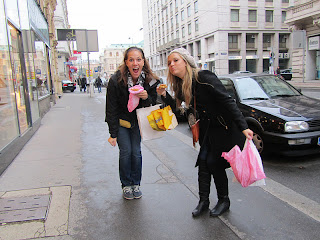backtrack to October 26 - otherwise known as our second day in Vienna. Christine and I wanted to show Kiley all throughout the heart of Vienna (tracing our steps from the walk with John) before going to the Hofburg Palace. Little did we know it was Vienna's National Day, which meant some free admission and people everywhere. National Day in Vienna commemorates the State Treaty restoring national sovereignty and the end of occupation when the last WWII troops left Austria.
Hofburg Palace is complex, confusing and imposing. The first Habsburg residence grew with the family empire from the 13th century until 1913 when the last "new" wing was opened. Six hundred years of Habsburgs lived in the palace which started as a 13th century medieval castle and now is 240,000-square meter complex.This was the winter residence of the Habsburg rulers until 1918 and now is home to the Spanish Riding School, the Vienna Boy's Choir, the Austrian presidents office, 5,000 government workers and several important museums. We went into the Palace to see the Imperial Apartments (also known as Kaiserappartments) lavish, Versailles type royal rooms. The Palace is divided up into three main sections: a porcelain and silver collection, a museum dedicated to Empress Sisi and the Imperial Apartments.
We started in the porcelain and silver collection... some pictures to show the CRAZY amounts of porcelain, silver and tableware. Fun Fact: napkin folding is a very important technique for the royal dining experience. Some folds were only known to 2 -3 people with the instructions being passed down by word or mouth.
Then onto the Sisi Museum which is dedicated to Empress Elisabeth who was said to be mysterious, beautiful and narcissistic. The museum traces her fabulous but tragic life. Clothing from her personal wardrobe is on display and you can admire her excessively thin waist ( 20in at age 16, 21in at age 50 after giving birth to four children) The museum explains her obsession with beauty and exercise. Her life began a tragic spiral after her son committed suicide, she would dress head to toe in black. In 1898 she was murdered by an Italian anarchist.
The Imperial Apartments, otherwise known as the Emperors Rooms. Some of the rooms were went through included the waiting room for the Audience Room, the Audience Room, conference room, Franz Josef's study, his bedroom, the Large Salon and the Small Salon - then the Empress' Rooms. I was especially intrigued by her exercise/ dressing room where servants worked for hours a day on her famous hair, while she passed the time reading and learning languages. The thought that the Hofburg Palace is the small winter residence blew my mind as we were walking through the various rooms and waiting rooms.
After touring the Palace we went out to the Palace gardens were the majority of the National Day festivities were being held. There were exhibits of all the military vehicles and forms of transportation on display with many men dressed in uniform. There were also food stands set up everywhere selling sausages, beer, pretzels, candy. Sticking with our rule we stopped by a tent and ordered what the majority of the locals were eating sausages and spicy mustard... our day in Vienna was coming to an end and we had to catch a 7pm bus to Budapest so we walked back to the hostel to grab our things.... not without stopping for a famous Austrian Apple Strudel.
sausage & spicy mustard
just munching on some apple strudel










No comments:
Post a Comment